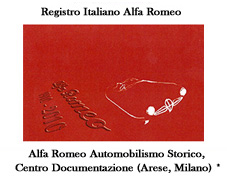
Alfa Romeo trademark is an icon of Italian creativity in the automobile sector. Since it appeared at the beginning of the last century, it has acquired an image of great prestige all over the world.
Alfa Romeo’s entrepreneurial history has been accompanied by some difficult and troubled moments; nevertheless, the quality of its products has never been damaged, nor have the passion, respect and affection to the trademark been influenced in any way. The development of its models has always been connected to technological innovation and to triumphs in competitions.
Even during the most dramatic moments, Alfa Romeo has maintained unchanged its competitive engagement; not for market reasons, but because races were in the DNA of entrepreneurs, both public and private, designers, staff and sport clients.
Even when this engagement was momentarily suspended, its spirit remained unchanged and calm inside, while outside some Alfa Romeo branches carried on the Italian automobile tradition: the Ferrari, we mustn’t forget, was born as Scuderia Ferrari from the Alfa Romeo Racing Team.

The post-WWII industrial revolution marked the entrance of Alfa Romeo into the group of the biggest automobile producers, starting with 1900 and 1900 TI models. Since its appearance, the latter earned the title of “race-winning family car” on the field. So it was for the successive models: the Giulietta, the symbol of the Italian economical miracle, and for Giulia. In different models, these cars dominated the field for more than 20 years throughout the world, opening the hearts of new legions of fans and supporters to the Italian brand.

Gens Italica and its Auriga Club, dedicated to Italian historical automobiles, couldn’t miss the celebrations for Alfa Romeo’s centenary. According to the spirit of our project “Symbols of Italy in the world”, carried on under the aegis of the Ministry of Cultural Heritage and Activities, we intend to bring back to life some of the cars identified as symbols of the green snake, the famous “biscione”, as well as the personas, women and men, related to them. Their stories are dedicated to all of the Italian communities abroad.
 In 1925, P2 racing car brought to Alfa Romeo the first Formula One World Champion Cup, won during the Italian Grand Prix in Monza in September, in front of a large and enthusiastic audience.
In 1925, P2 racing car brought to Alfa Romeo the first Formula One World Champion Cup, won during the Italian Grand Prix in Monza in September, in front of a large and enthusiastic audience.

This victory brought a laurel wreath to Alfa Romeo’s logo, unchanged for fifty years until 1975.

The 158 racing car, also affectionately called “alfetta”, was born at the end of the Thirties but was still relevant in 1950 when it won with Giuseppe Farina the first Formula One World Champion of the modern era.

Its successor, the 159, repeated its success in 1951, launching Juan Manuel Fangio into the firmament of elite drivers. Fangio was a forty year-old Argentine with a long and fantastic career ahead.

It was in 1952 that 1900 C52 “Flying Saucer Spider”, with an engine derived from the 1900 sedan, left everybody dumbfounded: its futuristic design is relevant till today. A six-cylinder 3,5 litres version was outfitted, and came in absolute second in the 1953 Thousand Mile race with Juan Manuel Fangio. “Flying Saucer” became an Alfa Romeo legend.

The Alfa Romeo Italian Register, that since 1962 has united all the devoted fans of this brand, now has chosen to offer this model to Milan as a monument capable of passing on the memories and sentiments of the historic Portello factory, from which the mythical green snake’s automobiles have departed to conquer the world. We have put great care into this initiative for the centenary, and invite all the Alfa Romeo supporters, above all the Italian communities and those of Italian origins, to participate with a tangible support as indicated on the Register’s website.

Finally, and we’re at the end of the Sixties, Alfa Romeo presents another jewel: Road 33: like a true jewel, it inspires respect and costs as much as a racing car. In this period Europe is marked by big social and political protest movements, so its commercial success failed. But the few exemplars produced are now legendary.
To celebrate the centenary, we whish to dedicate a particular photo gallery to the great Alfa Romeo sedans: born as symbols, we have missed them for too many years.
* Reproduction and duplication of these images are forbidden. All of pictures are kindly provided by

Back to Projects

